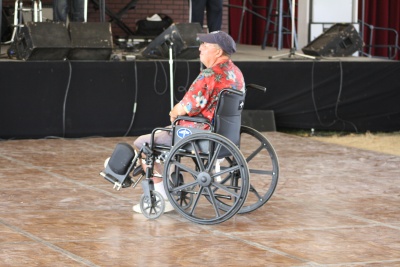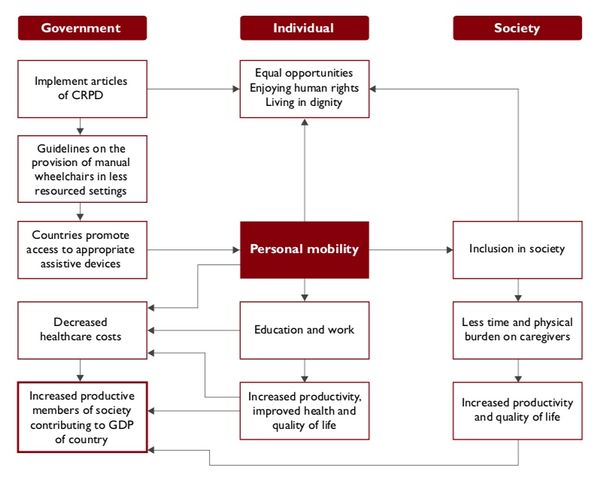Role of the Wheelchair
Original Editor - Priya Gulla as part of the Wheelchair Service Provision Content Development Project
Top Contributors - Naomi O'Reilly, Kim Jackson, Simisola Ajeyalemi, Lucinda hampton, Jess Bell, Priya Gulla, Amrita Patro, Samuel Adedigba and Lauren Lopez
Introduction[edit | edit source]
The wheelchair is one of the most commonly used assistive devices to promote mobility and enhance quality of life for people who have difficulties in walking (e.g. a person with spinal cord injuries resulting in quadriplegia or paraplegia, muscular dystrophy,etc). Wheelchair mobility opens up opportunities for wheelchair users to study, work, engage in social activities and access services such as healthcare.[1] In addition to providing mobility, an appropriate wheelchair benefits the physical health and quality of life of the users by helping in reducing common problems such as pressure sores, progression of deformities and improve respiration and digestion.
To ensure effective mobility, wheelchair users need a wheelchair which fits them correctly and meets their specific needs[2].
Many people in the world have a physical disability and require a wheelchair:[3]
- In the 34 developed countries, an estimated 10,000,000 people (i.e. 1% of the population) require a wheelchair
- In the 156 developing countries, around 121,800,000 people are estimated to require a wheelchair (i.e. at least 2% of the population)
- The world population is 7,091,500,000, so approximately 131,800,000 people (or 1.85% of the global population) require a wheelchair
Many people in the world need a wheelchair, but don’t have one:[3]
- In developed countries, less than 500,000 require a wheelchair, but do not have access to one (5% of 10 million)
- In developing countries, at least 109,620,000 people require a wheelchair, but do not have access to one (90% of 121.8 million)
- Thus, just over 110,000,000 people do not have access to a wheelchair
Appropriate Wheelchair[edit | edit source]
A wheelchair is appropriate when it meets the individual’s needs and environmental conditions; provides proper fit and postural support based on sound biomechanical principles; is safe and durable; is available and can be accessed, maintained and sustained in the country at the most economical and affordable price. [4] An appropriate wheelchair can assist in opening up a new world for the user, from exclusion to inclusion, participation in all societal activities, and sports and recreation, which all lead to independence, better health and improved quality of life. [5]
| Physical Needs | Intended Use |
|---|---|
| The ability to adjust or customize a wheelchair to meet the user’s physical needs will vary, depending on the type of wheelchair. Wheelchairs should be available in at least a small range of sizes and allow some basic adjustments. Wheelchairs designed for temporary uses (e.g. to be used in a hospital to move patients from one ward to another) are not designed to provide the user with a close fit, postural support or pressure relief, while for long-term users, a wheelchair must fit well and provide good postural support and pressure relief. A range of seat widths and depths, and the possibility to adjust at least the footrest and backrest height are important in ensuring that the wheelchair can be fitted correctly. Other common adjustments and options include cushion types, postural supports and an adjustable wheel position. Highly adjustable or individually modified wheelchairs are designed for long-term users with special postural needs. Such wheelchairs often have additional components added to help support the user. | Wheelchair designs vary to enable users to safely and effectively use their wheelchair in the environment in which they live and work. A wheelchair that is used primarily in rough outdoor environments needs to be robust, more stable and easier to propel over rough ground. A three-wheeled wheelchair would be well suited to outdoor use. In comparison, a wheelchair that is used indoors on smooth surfaces needs to be easy to manoeuvre in small indoor spaces. Many users live and work in a range of settings, and a compromise is therefore often necessary such as a robust wheelchair with a relatively short wheelbase but large castor wheels. This wheelchair could be used both indoors and outdoors. Users need to be able to get in and out of the wheelchair easily, to propel it efficiently and to repair it. Users may need to transport their wheelchair, for example in a bus or car. Different wheelchair designs allow for wheelchairs to be made more compact in different ways. Some are cross-folding, while others have quick-release wheels and the backrest folds forwards. |
Benefits of an Appropriate Wheelchair[edit | edit source]
Mobility devices are appropriate for people who experience a wide range of mobility difficulties as a result of a broad spectrum of health conditions and impairments, including amputation, arthritis, cerebral palsy, poliomyelitis, muscular dystrophy, spinal-cord injury, spina bifida, stroke and are also relevant for older people who experience mobility difficulties. Assistive technologies such as wheelchairs have been shown that, when appropriate to the user and the user’s environment, they have a significant impact on the level of independence and participation which people with disabilities are able to achieve. This also reduces the burden of care and has been reported to reduce the overall need for formal support services. [7]
Wheelchair provision is not only about the wheelchair, which is just a product [8], rather it is about enabling people with disabilities to become mobile, remain healthy and participate fully in community life. We often take the ability to move in our home and community for granted, but for individuals with a disability with mobility impairments even the smallest step can prevent them from accessing all parts of their life. Being mobile enhances a person’s ability to learn, interact with others, earn a living and participate in the community. A wheelchair is the catalyst to increased independence and social integration, but it is not an end in itself. Studies have shown that assistive technologies including wheelchairs, when appropriate to the user and the user’s environment, have a significant impact on the level of participation which people with disabilities are able to achieve and when provided through a supportive service have been reported to reduce the time and physical burden for caregivers. [9][10] The use of mobility devices, in particular, creates opportunities for education and work, and contributes to improved health and quality of life but may also have an impact on the prevention of falls, injuries, further impairments and premature death. Investment in provision of mobility devices can reduce health-care costs and economic vulnerability, and increase productivity and quality of life. [7]
The benefits of using an appropriate wheelchair are: [1][11]
Mobility[edit | edit source]
An active lifestyle has been proven to have both physical and mental health benefits with individuals participating in physical activity shown to have a reduced risk of cardiovascular disease, non-insulin-dependent diabetes mellitus, osteoporosis, osteoarthritis, and several cancers. An appropriate wheelchair provides the user the freedom to move around, allowing the user to access day to day physical activity as they push around conducting activities of daily living increasing overall physical activity levels and day to day mobility.[12] It also provides the greatest possible opportunity for independence and do the things they want to do, allowing indivduals to move within their home more easily, provides increased comfort and a more active lifestyle. [11]
Independence[edit | edit source]
Difficulty with ambulation, need to frequently lean on someone or hold onto their arm as they walk next to you, decreased balance, fear of falling can all cause individuals to become isolated from friends and family. A wheelchair that is functional, comfortable and can be propelled efficiently can result in increased levels of activity. Independent mobility and increased physical function can reduce dependence on others. Thus, wheelchair user's can be more independent and more in control of their own life. Individuals who experience the least discomfort when sitting are often more productive. Users who are able to spend more time in their wheelchair will have more opportunities for participating in day-to-day life along with others in the household, greatly improving their quality of life. [11]
Health[edit | edit source]
A wheelchair can improve the user's health in many ways. A wheelchair that is functional, comfortable and can be propelled efficiently can result in increased levels of physical activity, thus improving both physical and mental health. A well fitting wheelchair with cushions, combined with adequate user training, can reduce common problems, such as pressure sores, the progression of deformities or contractures, and other secondary conditions associated with poor postures.[11] [13] Other benefits, such as improved respiration and digestion, increased head, trunk and upper extremity control and overall stability, can be achieved with proper postural support. Maintenance of health is an important factor in measuring quality of life. These factors combined serve to increase access to opportunities for education, employment and participation within the family and the community.[11]
Self Esteem & Self Confidence[edit | edit source]
Self-esteem is described as a general evaluation of one’s self- concept or sense of personal worth and adequacy with high self-esteem linked to many positive health outcomes in persons with a disability including reduced depression and higher life satisfaction and well-being. Wheelchairs have been shown to have a profound influence on quality of life and participation. Wheelchair users may become more confident and have more self esteem when they have a wheelchair, often viewed as an extension of the users body, that fits them and which they can use well, therefore the chair’s weight and dimensions effect the person’s ability to negotiate through the home and in the community. Research has shown that wheelchair users with higher self-esteem displayed increased participation levels independent of gender, age and disability type. [14]
Quality of Life[edit | edit source]
With maintenance of health there is increase access to opportunities for education, employment and participation within the family and the community. These factors also contributes in increasing quality of life of wheelchair user. [11]
Access to Community Life[edit | edit source]
Access to community life including community participation, involving both being active in family and community life with engagement in typical roles and responsibilities in society plays a key role in the health and wellbeing of wheelchair users and has been shown to be a key factor in preventing health deterioration in individuals with spinal cord injury. Being able to access the community, move outside the home is important for social participation and engagement and many positive health indicators as well. Having an appropriate wheelchair improves access to the community and enables wheelchair users to be more involved in community life i.e. it enables the user to go to the work or school, visit friends, attend places of worship or other community activities. Additionally, appropriate wheelchairs influence individual autonomy because they facilitate both mobility and activities of daily living both in the home and in the community. [14]
Economy[edit | edit source]
A wheelchair often makes all the difference between being a passive receiver and an active contributor. Economic benefits are realized when users are able to access opportunities for education and employment. With a wheelchair, an individual can earn a living and contribute to the family’s income and national revenue, whereas without a wheelchair that person may remain isolated and be a burden to the family and the nation at large. Similarly, a wheelchair that is not durable will be more expensive owing to the need for frequent repairs, absence from work and eventual replacement of the wheelchair. Providing wheelchairs is more cost-effective if they last longer. It is also more cost-effective if users are involved in selecting their devices and if their long-term needs are considered. [11]
For society, the financial benefits associated with the provision of wheelchairs include reduced health care expenses, such as those for treating pressure sores and correcting deformities. A study from a developing country reported that in 1997, 75% of those with spinal cord injuries admitted to hospital died within 18–24 months from secondary complications arising from their injuries. In the same place, the incidence of pressure sores decreased by 71% and repetitive urinary tract infections fell by 61% within two years as a result of improvements in health care training and appropriate equipment, including good wheelchairs with cushions. [11]
Challenges for Wheelchair Users[edit | edit source]
Financial Barriers[edit | edit source]
Some 80% of the people with disabilities in the world live in low-income countries. The majority of them are poor and do not have access to basic services, including rehabilitation facilities. The International Labour Organisation reports that the unemployment rates of people with disabilities reach an estimated 80% or more in many developing countries. Government funding for the provision of a wheelchair is rarely available, leaving the majority of users unable to pay for a wheelchair themselves. [11]
Physical Barriers[edit | edit source]
Majority of wheelchair users are poor, with inaccessible surroundings. They also live where road systems are poor, there is a lack of pavements, and the climate and physical terrain are often extreme. In many contexts, public and private buildings are difficult to access in a wheelchair. These physical barriers place additional requirements on the strength and durability of wheelchairs. They also require that users exercise a high degree of skill if they are to be mobile. [11]
Access to Services[edit | edit source]
In many developing countries, only 3% of people with disabilities who require rehabilitation services have access to them. According to a report of the United Nations Special Rapporteur, 62 countries have no national rehabilitation services available to people with disabilities. This means that many wheelchair users are at risk of developing secondary complications and premature death that could be avoided with proper rehabilitation services. [11]
Education and Information[edit | edit source]
Many users have difficulty in accessing relevant information, such as on their own health conditions, prevention of secondary complications, available rehabilitation services and types of wheelchair available. For many, a wheelchair service may be their first access to any form of rehabilitation service. This places even more emphasis on the importance of user education. [11]
Personal Choice[edit | edit source]
Users are rarely given the opportunity to choose the most appropriate wheelchair. Often there is only one type of wheelchair available (and often in only one or two sizes), which may not be suited to the user's physical needs, or practical in terms of the user's lifestyle or home or work environment. According to the Convention on the Rights of Persons with Disabilities, “States Parties shall take effective measures to ensure personal mobility with the greatest possible independence for persons with disabilities … by facilitating the personal mobility of persons with disabilities in the manner and at the time of their choice, and at affordable cost”. [11]
Stigma[edit | edit source]
Community, Government, and Non-Government ignorance and stigma in relation to people with a disability and wheelchair use including poor understanding of the principles of a quality wheelchair, and reduced rights of the users to access their environment / community which include:
- Poor road designs that do not consider the needs of wheelchair users
- Drivers not sensitive to the road needs of wheelchair users
- Inaccessible buildings
- Lack of easily accessible skilled service providers for wheelchair maintenance
- Innaccessible and costly public transport with limited space available for wheelchair users
References[edit | edit source]
- ↑ 1.0 1.1 Sarah Frost, Kylie Mines, Jamie Noon, Elsje Scheffler, and Rebecca Jackson Stoeckle. Wheelchair Service Training Package - Reference Manual for Participants - Basic Level. Section A. Core Knowledge.World Health Organization, Geneva. 2012
- ↑ Susan Allen, Linda Resnik and Jason Roy; Promoting Independence for Wheelchair User's : The Role of Home Accomodations, The Gerontological Society of America, 46: 115-123, 2006.
- ↑ 3.0 3.1 Wheelchair Foundation. Wheelchair needs in the world. Available from:https://www.wheelchairfoundation.org/fth/analysis-of-wheelchair-need/ (accessed 13 Junes 2022).
- ↑ William Armstrong, Johan Borg, Marc Krizack, Alida Lindsley, Kylie Mines, Jon Pearlman, Kim Reisinger, Sarah Sheldon. Guidelines on the Provision of Manual Wheelchairs in Less Resourced Settings. World Health Organization; Geneva: 2008.
- ↑ Sarah Frost, Kylie Mines, Jamie Noon, Elsje Scheffler, and Rebecca Jackson Stoeckle. Wheelchair Service Training Package - Reference Manual for Participants - Basic Level. Section A. Core Knowledge.World Health Organization, Geneva. 2012
- ↑ Assistive Technology for All. WSTP Intermediate Video Series: 3. The Benefits of an Appropriate Wheelchair. Available from: https://youtu.be/SvMeU31Gwe8 [last accessed 30/10/17]
- ↑ 7.0 7.1 USAID and World Health Organisation. Joint Position Paper on the Provision of Mobility Devices in Less-Resourced Setting - A Step Towards Implementation of the Convention on the Rights of Persons with Disabilities Related to Personal Mobility. World Health Organisation, Geneva. 2011
- ↑ Krizack, M. It’s Not About Wheelchairs. Whirlwind Wheelchair International, San Francisco, Ca, 2003 (http://www. whirlwindwheelchair.org/articles/current/article_c02.htm, accessed 8 march 2008).
- ↑ World Health Organization,World Bank World Report on Disability. Geneva:World Health Organization; 2011 (http://www.who.int/disabilities/world_report/2011/report/en/).
- ↑ Allen S, Resnik L, Roy J. Promoting Independence for Wheelchair Users: The Role of Home Accommodations. Gerontologist, 2006;46(1):115–123.
- ↑ 11.00 11.01 11.02 11.03 11.04 11.05 11.06 11.07 11.08 11.09 11.10 11.11 11.12 William Armstrong, Johan Borg, Marc Krizack, Alida Lindsley, Kylie Mines, Jon Pearlman, Kim Reisinger, Sarah Sheldon. Guidelines on the Provision of Manual Wheelchairs in Less Resourced Settings. World Health Organization; Geneva: 2008.
- ↑ Tolerico ML, Ding D, Cooper RA, Spaeth DM. Assessing mobility characteristics and activity levels of manual wheelchair users. Journal of rehabilitation research and development. 2007 May 20;44(4):561.
- ↑ Howitt J. Patronage or Partnership? Lessons Learned from Wheelchair Provision in Nicaragua [Thesis]. Georgetown University, Washington DC, 2005.
- ↑ 14.0 14.1 Rice IM, Wong AW, Salentine BA, Rice LA. Differences in participation based on self-esteem in power and manual wheelchair users on a university campus: a pilot study. Disability and Rehabilitation: Assistive Technology. 2015 Mar 4;10(2):102-7.









